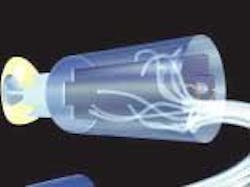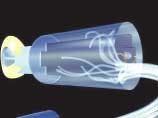Scotland funds optical lock
When put into practice, the brainchild of an entrepreneur from Crieff, Scotland, is set to become what may be an unpickable lock. The lock design relies on optical fibers for encoding, avoiding vulnerable mechanical components. The Scottish Executive (the portion of the Scottish government not connected with the U.K. government) has awarded Jeremy Rice a £50,000 (US$91,576).grant to implement his "Optilock" idea.
Optilock comprises a lock barrel that is surrounded by incomplete 3-D optical pathways. Light signals are sent through the input fibers, which start transmission when a magnet at the end of the key trips a reed switch at the end of the lock barrel. Passive fiberoptic pathways join the inputs and outputs around the lock barrel in a unique way; as the key is inserted, it completes the optical circuit. The output fibers feed to optical sensors, which check that the light signals are present. When this process is complete, a solenoid bolt, motor, or other output device is activated, unlocking the door or enabling the ignition circuit.
Optilock cannot suffer from mechanical intrusion as there are no moving parts in the lock barrel. It emits no radio-frequency signals that could be collected for unauthorized use. As only light passes through the lock barrel, Rice claims that the lock will work in harsh environments with extremes of temperature, underwater, or in environments where explosive gases may be present.
"Because it uses optical fibers, it is extremely difficult to get around," says Rice. "Even if you were to drill around the lock, you would still have to link up all the fibers correctly to be able to open it. The only way to open the lock would be with a duplicate key, which would be extremely difficult to copy. Due to Optilock's 3-D pathways, you potentially have billions or even trillions of combinations depending on how the lock is made."
Rice notes that he took advice from several companies in the industry, with all feedback—positive or negative—going into improving the design. "I'm also working with technical advisors from two universities," says Rice. "The funding I have been awarded gives me a great opportunity. Following the feasibility and development process, a clearer picture of manufacturing costs and processes will emerge, enabling future mass production."
Rice has obtained patents for Optilock in several countries. The first versions are being designed for the automotive industry; Rice notes that there is already interest from a major car manufacturer.

